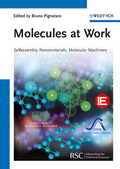Molecules at Work
Selfassembly, Nanomaterials, Molecular Machinery

1. Edition April 2012
XVIII, 392 Pages, Hardcover
180 Pictures (30 Colored Figures)
12 tables
Monograph
Short Description
Providing a comprehensive overview of current developments in innovative materials science and related topics, this book covers the core areas of materials science, inorganic, organic and solid state chemistry.
Buy now
Price: 135,00 €
Price incl. VAT, excl. Shipping
Euro prices for Wiley-VCH and Ernst & Sohn titles are only valid for Germany. In EU countries, local VAT applies. Postage will be charged.
- Out of print -
This book contains the contributions of selected young chemists from the field of nanotechnology and material sciences. The contributions
are grouped under the following umbrella topics:
Self assembly
Nanomaterials
Molecular Machinery
This volume is an indispensable read for all materials scientists, organic, and inorganic chemists, Ph.D. students in chemistry and
material sciences interested in seeing what tomorrow's chemistry will look like.
PART I: Self Assembly
YOCTOLITER-SIZED VESSELS AS POTENTIAL BIOLOGICAL MODELS
Introduction
Cavities on Glass Plates and Gold Surfaces
Preparation and Confirmation of Rigid Yoctowell Cavity
Molecular Sorting
Yoctowell-Based Molecular Recognition Events
Conclusion
SWITCHABLE HOST-GUEST INTERACTIONS OF SUPRAMOLECULAR RINGS AND CAGES
Introduction
Host - Guest Chemistry
Switching in Supramolecular Systems
Natural Paragons
Types of External Input and Methods for Analysis
Conclusion
PART II: Nano Materials
TAILORED GRAPHENE-TYPE MOLECULES BY CHEMICAL SYNTHESIS
Introduction
Synthetic Concepts toward Expanded PAHs - Nanographenes
Conclusion and Outlook
ANALYZING THE SURFACE AREA PROPERTIES OF MICROPOROUS MATERIALS
Introduction
Microporous Materials
Porosity
Porous Materials and Calculating Surface Areas
Summary
NANOSTRUCTURED MATERIALS BASED ON CORE-SUBSTITUTED NAPHTHALENE DIIMIDES
Introduction
Synthesis of Novel cNDI Derivatives
Electron Transfer
Supramolecular Self-Assembly of cNDI
Conclusion
METAL PHOSPHIDES: FROM CHEMIST'S ODDITIES TO DESIGNED FUNCTIONAL MATERIALS
Introduction
Bulk Metal Phosphides: A Long History
White Phosphorus for the Low-Temperature Synthesis of Metal Phosphide Nanoparticles
'ARTIFICIAL SUPERMOLECULE': PROGRESS IN THE STUDY OF II - V COLLOIDAL SEMICONDUCTOR NANOCRYSTALS
Introduction
Optical Properties of II - V Nanocrystals
Synthesis of II - V Nanocrystals
Conclusions and Outlook
LUMINESCENT DENDRIMERS
Introduction
Intrinsic Photochemical and Photophysical Properties of Organic Dendrimers
Energy Transfer and Energy Upconversion in Multichromophoric Dendrimers
Dendrimers as Ligands for Metal Ions
Self-Assembly
Dendrimers as Photoswitchable Hosts
Conclusion and Perspectives
FABRICATION OF ULTRAMICROPOROUS SILICA MEMBRANES FOR PERVAPORATION AND GAS SEPARATION
Ultramicroporous Silica Membranes
MxOy - Silica Membrane
Hybrid Organic-Silica Membranes
Perspectives in the Fabrication and Application of Silica Membranes
NEW DIRECTIONS IN THE FIGHT AGAINST CANCER: FROM METAL COMPLEXES TO NANOSTRUCTURED MATERIALS
Introduction
Metal Complexes in Cancer Treatment
Nanostructured Materials in Cancer Treatments
PART III: Molecular Machinery
MOLECULAR ROTORS IMAGING INTRACELLULAR VISCOSITY
Introduction
Theoretical Background
Biological Applications of Molecular Rotors
Conclusions and Outlook
SURFACE-FUNCTIONALIZED INORGANIC COLLOIDAL NANOCRYSTALS IN FUNCTIONAL
NANOCOMPOSITE MATERIALS FOR MICROFABRICATION
Introduction
Colloidal Nanocrystals: Properties, Synthesis, and Surface Functionalization
NC-Based Nanocomposites for Microfabrication
Conclusions and Future Perspectives
FLUORESCENCE SENSING OF TEMPERATURE AND OXYGEN WITH FULLERENES
Introduction
Thermally Activated Delayed Fluorescence: Fundamental Aspects
Sensing Applications
Conclusions and Future Perspectives
GOING BEYOND GLUCOSE SENSING WITH BORONIC ACID RECEPTORS
Introduction
Indicator Displacement Assays for the Detection of Sugars
Glucose Sensing with Boronic Acid Receptors
Solution-Phase Sensor Arrays with Boronic-Acid-Appended Bipyridinium Salts
Carbohydrate-Active Enzyme Assays
Boronic-Acid-Appended Bipyridinium Salts at Work - NOVOSIDES
Conclusions and Perspectives
DESIGN OF NOVEL IRIDIUM COMPLEXES TO OBTAIN STABLE AND EFFICIENT LIGHT-EMITTING ELECTROCHEMICAL CELLS
Brief History of Electroluminescence and Optoelectronic Devices
Light-Emitting Electrochemical Cells: Motivation and Definition
Ionic Transition-Metal Complexes Based on Ir(III) Metal Core for LECs
Strategies to Design Iridium(III) Complexes for Highly Efficient LECs
Strategies to Design Iridium(III) Complexes for Highly Stable LECs
Outlook and Conclusions
PHOTOCHEMICALLY DRIVEN MOLECULAR DEVICES AND MACHINES
Introduction
Switches and Logic Gates
Molecular Machines
Conclusions


